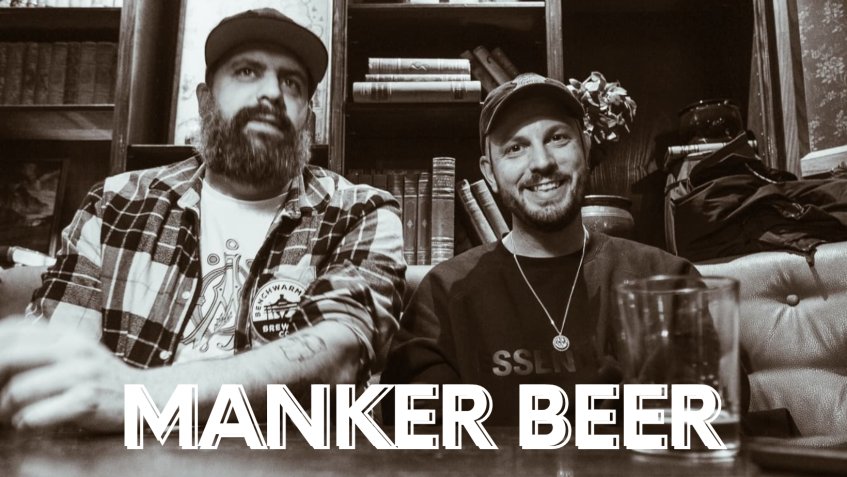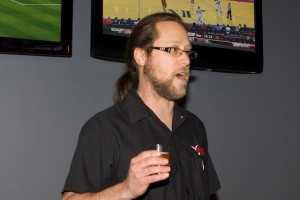Thanks to a beer trade earlier this year I was sent two bottles or american sour beers from a tiny brewery I had not yet heard of – Freetail Brewing Company. When I read up on them I was surprised to learn that they were from the somewhat less craft beer brewery populated state of Texas. Except for St. Arnold and Jester King I didn’t know much of the Texas beer scene. The sours were both really tasty and I wanted to know more about the San Antonio brewpub. Luckily our pre-Great American Beer Festival interview series came up and as I got word that Freetail were now expanding from brewpub to opening a second location we contacted head brewer Jason Davis to see if we could get their story and learn more about them. Jason happily agreed and the result is what you find below.
MankerBeer (MB): You have a rather limited distribution so I guess few Europeans, and even Americans know Freetail Brewing Co. Could you tell us who you are and the story behind Freetail.
Jason Davis (JD): Freetail is a small brewpub founded in San Antonio in November 2008. The official story on the website:
Way back yonder on the eve of 2006 a dude named Scott was on a ski trip with friends when he had an epiphany. Maybe it was the lack of oxygen at altitude, or maybe it was all the tasty local beer he had consumed, but he had determined to open a brewery restaurant in his hometown of San Antonio. A little under three years later, Freetail Brewing Co. took flight with a full serving of punk, a dash of ska, a pinch of funk and the random sprinkling of everything else.
Together with Chef Gary Butler and Head Brewer Jason Davis, we are committed to our Mission of “Bringing the Pursuit of Better Stuff to fruition for our customers, employees and community in everything we do.” Whether it’s for pints, a bite, or just a place to hang with friends or catch a game, we want you to have a great time doing it.
We make three year round brews: La Rubia–our requisite blond ale; Rye Wit–a refreshing twist on the Belgian classic; Freetail Ale–a malt-forward American amber. In addition to these, we try to keep a wide variety of taps flowing, including a healthy rotation of IPA’s and Belgian-inspired seasonals. We have made a name for ourselves with our bottle release parties which feature barrel-aged wild brews like Ananke, Woodicus and Fortuna Roja and our yearly release of La Muerta–a smoked Imperial Stout–which coincides with Dia de los Muertos–a Mexican tradition honoring the dead following Halloween.
Our green Spirulina Wit was named one of the 10 strangest beers in the US and our Ananke was named one of the top rare bottle releases.
MB: Texas and San Antonio have never been really famous for their craft beer scene, but with you, Jester King and others it seems to change. What has changed?
JD: It’s hard to say what may have changed, other than the love of craft beer sweeping the country has finally trickled through our archaic liquor control laws and galvanized a state full of beer drinkers. The enormous potential of this market is only beginning to be fully realized by brewers here and outside the state. Freetail and Jester King are only the tip of the iceburg–there are two great regional brewers making great beer here, Real Ale and St. Arnold, and a plethora of smaller breweries popping up all over the state. Texas is one of the fastest growing brewing scenes in the country.
MB: You guys seems to be taking the beer business for what it is, great people brewing great beer for great beer drinkers. When reading the letter CEO Scott Metzger wrote to a certain Oregon based brewery regarding the name of a certain beer I break up in laughter, has the beer business got to serious?
JD: It may seem so, but I don’t believe seriousness is the culprit or the target of Scott’s irony in that letter. The strength of the craft beer movement has been in our camaraderie and the work we have done together to build in roads to the bigger business of beer. As we grow, commanding more market share, more SKU’s, more shelf and tap space, we need to remember our roots as friends and fellow brewers with similar goals and needs. Scott’s point was “all you had to do was ask”–that’s what friends do. Once lawyers are involved, somebody’s gone too far.
MB: The amount of US craft breweries has reached an all time high, is there room for all these breweries? It seems so weird when breweries are fighting over employees and names of their beers and breweries when several of them do not even distribute outside their local or regional markets.
JD: Certainly we are seeing a spike in growth which will not be sustainable for long–in my opinion. I worry about the fallout once the bubble bursts as it did in the 90’s. Closing breweries is no fun. Still, breweries who have found their niche–whether a style of brewing, a must-have flagship brand, or a loyal local market–will be the ones remaining while newer brewers brewing “the same old thing” or “the latest trend” and making the same mistakes of old (quality, over-reach) will be the first to close. Still, as the Texas beer scene grows, it is still far from saturated–of the two regional brewers I mentioned only one is just beginning to market its product outside of the state.
MB: The new location, Freetail2, is on its way and with it you might be able to distribute at least regionally. How much would you have to grow distributionwise to even consider wider distribution within the US or internationally?
JD: I don’t know if we will ever distribute outside of Texas. As I’ve said–we have a long way to go before we saturate even the San Antonio market. Scott would definitely be able to answer this more precisely, but I am paraphrasing him anyway. As of now, we will still only be a brewpub–that is, limited to 10,000 bbl/year. Exceeding that we would have three choices: 1) open another location, with the same limit 2) become a manufacturer and give up the right to sell wine, guest beer and beer to go or 3) change the laws again. My choice would be to continue building brewpubs–I have no dreams of world-domination. But you never know with Scott…
MB: When teaking a peak at what kind of beers you brew we find a crazy mixture of styles – what beer styles do you yourself prefer, both to drink and to brew?
JD: I love to try all kinds of new beers whenever I have the chance. I love wit beer and I hope that love shines through in my versions of the style here. I like a solid, well-balanced IPA and other hoppy beers (Real Ale’s Hans’ Pils is a staple at home). I lean towards session beers, but appreciate all kinds. I have a special place in my heart for very smoky rausch beers and the wild beers of Payottenland–especially Cantillon. I love to brew beer in general, but really enjoy formulating new beers and using odd ingredients. Whenever a new beer is ready from our barrel-aging program, I am always astonished by its nuance of acidity, sweetness, spice and residual malt. Very rewarding.
MB: I see a lot more berliner weisses, lichtenhainers and other traditonal, but previously forgotten beer styles on the market today – are sours and these types of beers the new trend replacing IPA’s?
JD: I don’t believe so. Whatever IPA–or IPA’s–we have on tap at a given time are our best sellers. Sour beers absolutely have their place–and their fans will pay good money for them. But they also are labor-intensive and take a long time to make. However, with something like a berliner–it is possible to brew it with a much faster turn-around–and in that case I believe there is room for both it and the IPA at the table (though I’ll wager the berliner will last longer). As they say, we’ve had a lupulin shift.
MB: With the new location, what will the brewing philosophy be? To focus on a line of steady year round brews or to mix it up and brew some of each like today?
JD: Both. Contrary to our customers’ belief, our year-round beers are our bread and butter and the folks who drink these beers day in and day out are our target market–they make it possible to branch out, experiment and brew all kinds of beers. We will always work to keep their pint glasses full. We may add an IPA or a lager to our lineup of year-round brews, and we will brew seasonal beers as well like La Muerta and Old Bat Rastard. In addition, we’ll greatly expand the volume of our barrel-aging program (not necessarily the variety). Finally, Freetail 1 will be freed up to produce more experimental beers, brew one-offs and test-batches for Freetail 2 while serving the staples brewed at the new place.
MB: What are you looking forward to with GABF and how important is the festival for breweries and the American beer scene?
JD: This year we are going to be situated in the Brewpub Pavillion–a new feature last year which focuses on the brewpub experience–so it will definitely be fun to pour our beer in that environment. I look forward to being in Denver during beer week and visiting the local breweries–it never gets old for me. As for the importance–I’m not sure. It’s definitely a reflection of the craft beer cameraderie and a healthy spirit of competition. For packaging breweries it can be an important outlet for national exposure and I understand that a medal can do great things for your PR–I’ll let you know if we are ever so fortunate!
MB: . Are there anything all GABF-debutants reallly shouldn’t miss and/or think about at GABF?
JD: Enjoy the town as a whole–lots of great breweries and restaurants. Don’t miss Strange Brewing or Crooked Stave! The GABF itself can be quite overwhelming–you will never be able to sample even half of the beers being served. Stakeout the breweries you want to try and savor them! Take notes, pictures–do what you can to make the impressions last.
MB: What cool Freetail brews will be poured at the festival?
JD: This year we are bringing the aforementioned Spirulina Wit, Buffalo Hump 1840 IPA (Belgo-American), Witicus Double Rye Wit, and two American sours- Salado Kriek and Ananke.
Thank you Jason and good luck with the expansions, we hope to see more Freetail beers in the States and that some of them occasionally will make their way to Europe, Sweden and home to me.






